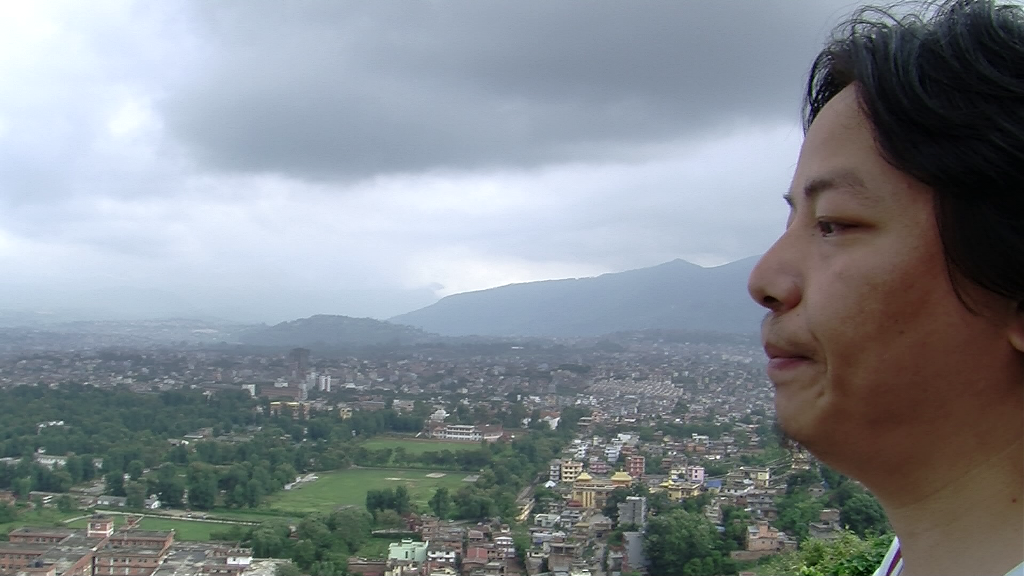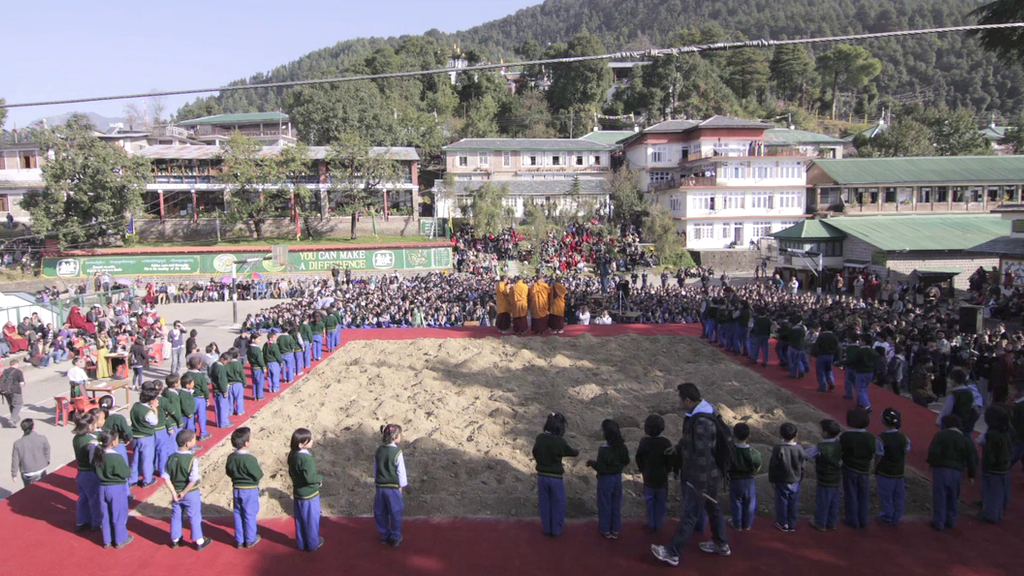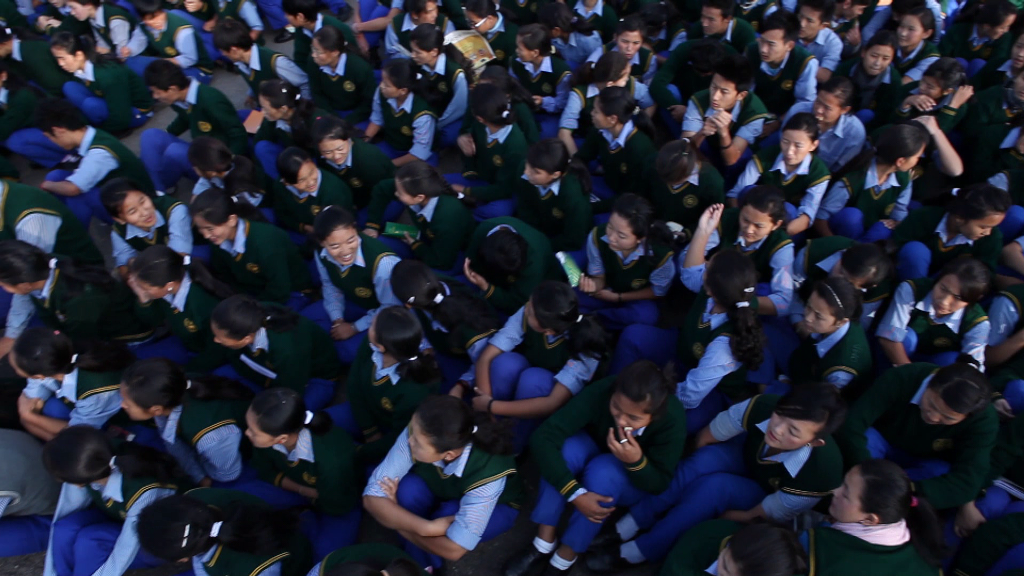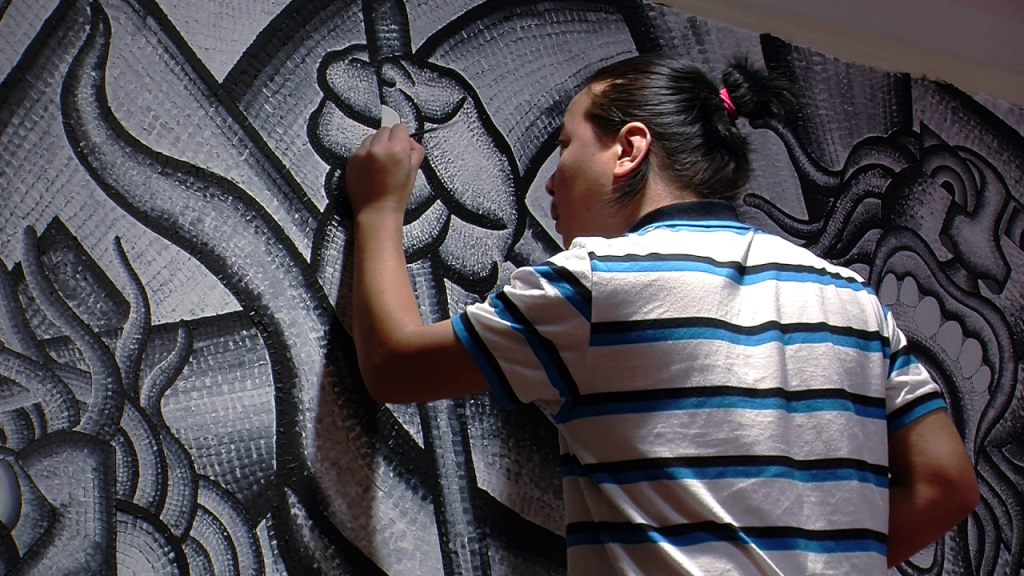An HRIC Conversation with Tenzing Rigdol
Click here for a Tibetan version of this interview.
An effort to fulfill a father’s wish became a project for the Tibetan people in exile. In 2011, New York based Tibetan artist Tenzing Rigdol had 20,000 kilos of soil from Tibet transported past border control to Nepal and then to Dharamsala, India, where most Tibetan exiles live. In October, in the Tibetan Children’s Village School, he created a platform of Tibetan soil. For three days, Tibetans came to set foot on the soil of their homeland, which His Holiness the Dalai Lama blessed. HRIC Executive Director Sharon Hom spoke with Tenzing Rigdol in June 2012.
Sharon Hom: What did you mean when you said you were called to meet his Holiness, but that you didn’t have time to prepare? Aside from putting on formal Tibetan dress, what would you need to be prepared?
Tenzing Rigdol: When it’s journalists, we know what they are going to ask. Meeting His Holiness is different. One needs to be mentally prepared, to be there, to really observe his presence fully, and enjoy it. Once he started coming into the room, everything just became so quiet. It was a very good personal experience. He took his finger, at first I didn’t know what he was going to do—was he playing with me? Then he wrote in Tibetan the word for Tibet in the soil, I thought it was really beautiful.
He gave me some fatherly advice—that we should communicate with Chinese individuals as individuals, that we should work in whatever way we can on the Tibetan issue, in art or in other fields. He said: “don’t lose hope.”
Sharon Hom: Did His Holiness go out to see the installation?
 Tenzing Rigdol: No, that’s why we presented him with the tray filled with soil. After he wrote in it, I took it back and put it at the installation, and people started paying their own respect, kneeling with their heads touching it, touching their heads to the word in the soil; people started taking it as a benediction.
Tenzing Rigdol: No, that’s why we presented him with the tray filled with soil. After he wrote in it, I took it back and put it at the installation, and people started paying their own respect, kneeling with their heads touching it, touching their heads to the word in the soil; people started taking it as a benediction.
Sharon Hom: Was all the soil taken away at the end?
Tenzing Rigdol: Yes, after three days, we invited people to take the soil and do whatever they wanted with it. Some wanted to grow flowers in it. I am curious to see what has happened when I go back to Dharamsala.
Sharon Hom: After almost eight months since the installation, do you have any overall sense of what the people did with each individual piece of soil? Maybe you can ask people to post pictures on your website.
Tenzing Rigdol: That’s a good idea! I will try that. At that time we built a microphone for people to express what they feel. Some people wrote down their feelings in written form. I think a few thousand of them did; almost 60 percent in Tibetan, and 30-40 percent in English. They’re really interesting, such as “I am third grade student … I promise on this soil that I will study really hard,” or “I am a teacher and I will do everything I can to teach.” All this is very inspiring. Almost like epigrams. I will scan them and put them into some kind of booklet, and I really like the idea of posting their photos… I am getting distracted just thinking about the idea of the pictures!
Sharon Hom: I really like your works. Performance pieces are by their nature ephemeral, but this piece seems to be living on. And instead of the artist as the sole creator, you have people taking a piece of the work, making promises to the future, making it a living piece.
Tenzing Rigdol: Initially when I had this idea, and when I was writing proposals, I was thinking this was my idea. Later, I realized that I was only a postman. The project was bigger than me. So I rewrote the proposal, and everywhere I had put “I,” I changed it to “i,” and also put my name in lower case. This is everyone’s project. I was very interested in how the people poured meaning into the project.
Sharon Hom: It’s wonderful that the reactions are not only about loss, nostalgia, and exile. They’re very hopeful: let’s grow something in it, let’s wear it, let’s save a piece for those not here. These reactions are such an important part of the ongoing meaning of a piece that is no longer there physically.
Tenzing Rigdol: Many times, we are expecting rationality too much. Sometimes we are just emotional beings. So when things are tactile—even something small, like this soil from Tibet—it is so much more powerful than giving you a theory. Tibetans are very rationale people. Any topic you put on the table, you will have five or six different views and debates. So I raised the stage six feet—very few Tibetans are taller than six feet—so that when they were approaching the stage they could only see the top of the stage but not the soil. So when they saw the soil, they responded in a purely emotional way. They didn’t have enough time to guard their reactions. Especially the really young kids, they were very positive. I thought they wouldn’t say anything, but they said really amazing things. Some only eight, nine years old, some even sang rap songs—very innocent and emotional and very powerful. Some were actually eating the soil, putting it on their face, on their head—it was all very vibrant, very active. I didn’t know where to look—so many things were happening.
Sharon Hom: The tactile is very important to trigger powerful reactions. We were once in the Memorial to the Victims of Holodomor, the man-made famine in 1932-33 in which many millions starved to death and many were forced into the desert to die. When they went into the desert, many took with them small pieces of earth from where they had lived. The pieces of earth were then passed on from person to person and then collected when the Museum was built. The earth is now displayed in a small mound on top of a metal column, inside glass, under a ray of light.
I know one of the inspirations for the project was to give something back to your father, to bring a piece of Tibet to him. But we have been talking now how your piece is so tactile and specific. Do you think that although Tibet is in some ways lost—the language, the culture—in another way, it’s also very alive, that your project is also about a Tibet that lives, and is carried inside the hearts, inside the spirits of Tibetans?
Tenzing Rigdol: Yes. Yes, many Tibetans inside Tibet say: Tibetans inside Tibet and outside are united by an outside force—the Chinese government. But this time—the unity was about the unity of history, but it is intimate like brothers and sisters talking about how nice it was when we were together. Many have seen the installation inside Tibet.
Sharon Hom: Have there been any Han reactions—abroad or inside China?
Tenzing Rigdol: I have seen one or two artists who were very moved by it and wanted to invite other friends to look at the project. They already know how Tibetans feel, but to see the separation from their homeland and connection with it in an explicit way is different. At the same time, many didn’t like it in the news media. Someone in the press was scolding the “Indian guy” for taking the soil—they thought I was Indian! Many didn’t understand the context—they said we could give you the soil if you wanted.
Sharon Hom: We were speaking with some young Tibetans about how important it is for us to have more effective ways to reach out and engage with the young Chinese, including Han Chinese abroad. Because of propaganda, I can see some initial resistance among young overseas Chinese to your project, such as asking, why you call your project “OUR Land, Our People.” If you could say something directly to those Han Chinese students—what would you say?
Tenzing Rigdol: First just leaving aside the film, whenever I meet my Chinese friends, I say, DON’T believe me. I am only giving you one side of the coin. You have the other side. I am just telling you my story. I am confident of my story, but you have your own intelligence that I respect. So respect your own intelligence and do more research, then decide.
As for the film, it started out as a personal issue, and then it became something about Tibet. I always say for me, it’s not about human rights. For me, Tibet is sometimes about resistance against corrupt power. I am very proud to be in that small group that has almost nothing yet refuses to bow down.
Sharon Hom: We never got to talk about your experience collaborating with Zhang Hongtu on the Liu Xiaobo project in December 2010. Hongtu thinks greatly of your work.
We were very happy as we wanted to create collaborative spaces, where Chinese and Tibetans can work together, learn from each other, and create something together.
Tenzing Rigdol: Hongtu is a great artist, a very nice guy. This was the first time I worked with a wonderful Chinese artist. I was very honored to meet him. I always wanted to meet young Chinese—not just young, but all Chinese— just to learn what they feel and think and share our stories.
Sharon Hom: Yes, we need to get past that propaganda wall that prevents people from listening or seeing. Your project creates space for sharing emotional truths and where people can see each other.
Tenzing Rigdol: Everyone was talking about their own stories, not this country or that, but about their own stories, and that has a potential to connect.
Sharon Hom: What were your expectations at the beginning? What did you learn?
Tenzing Rigdol: I have this really bad habit: if I have a powerful idea, whether it’s about writing, or translating, or something else, then I can’t do anything else. The idea came from my father and my father had a big imprint on it, but it is not only my father. He would say “I want to go to Tibet before I die.”
 He didn’t have citizenship so he died without citizenship. So first I thought if he cannot go, like many other Tibetans, maybe I can bring Tibet to them. I didn’t really think how people would respond. I was so involved in making the project happen. I involved people who really believed in the project because this kind of project needed people being very positive. Being too rational won’t get you much mileage. The whole project took more than 17 months—from concept to implementation. I was very lucky to have good positive energy.
He didn’t have citizenship so he died without citizenship. So first I thought if he cannot go, like many other Tibetans, maybe I can bring Tibet to them. I didn’t really think how people would respond. I was so involved in making the project happen. I involved people who really believed in the project because this kind of project needed people being very positive. Being too rational won’t get you much mileage. The whole project took more than 17 months—from concept to implementation. I was very lucky to have good positive energy.
Sharon Hom: Works of art often take on their own life. Was this project different than your other installations?
Tenzing Rigdol: Not really. I love my work but I don’t love it like other artists. Usually a week or so after completing an artwork, I see how I could have done better. I was worried—the night before the installation—would people come? Would people think this kid is crazy? With thousands of Tibetans involved, everyone making it so personal, I was scared. On the third day, it was gone, clean, nothing left of the soil ... and a new beginning.
Sharon Hom: We want the China Rights Forum online to be a forum for action too, to inspire people to be involved—to take their “piece of earth.” Is there anything you would like to say to the Chinese speaking, or any, audience?
Tenzing Rigdol: I don’t know what to say—just THANK YOU for watching! I am very happy and honored. I take this as a first step towards understanding more about China, making more friends, more Chinese friends. If there is something they don’t understand, I’ll show them the video, and say let’s be friends. Thank you for inviting me here.
Editors’ note
The making of “Our Land, Our People” is being made into a documentary film, entitled “Bringing Tibet Home,” directed by Tenzin Tsetan Choklay. Projected release date: December 2012.
For a description of the installation and film, see Tenzin Dorjee, “A Rehearsal Return: How Art & Cinema Help Tibetans 'Return Home'.”